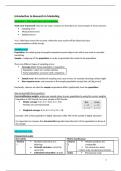Summary
Brief summary of all IRM lectures at Tilburg University
- Course
- Institution
Brief summary of the Introduction to Research in Marketing lectures. The topics covered are (in order): data exploration & visualization, ANOVA, linear regression, logistic regression, factor analysis and cluster analysis. The structure of the lectures has been maintained to make it easier to study...
[Show more]



